<Back to Index>
- Jacobite Pretender James Francis Edward, Prince of Wales, 1688
- Admiral and Politician Arthur Herbert, 1st Earl of Torrington, 1648
PAGE SPONSOR
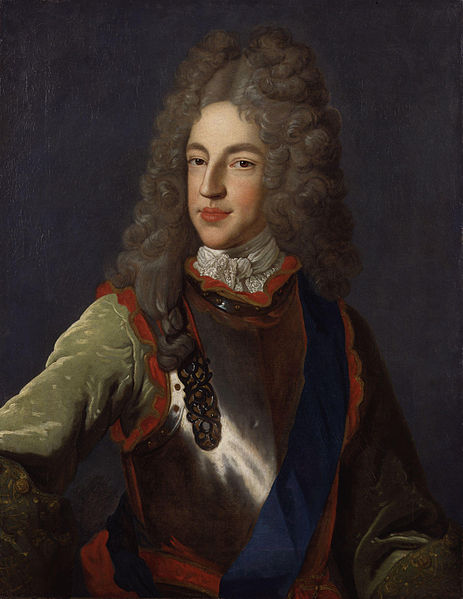
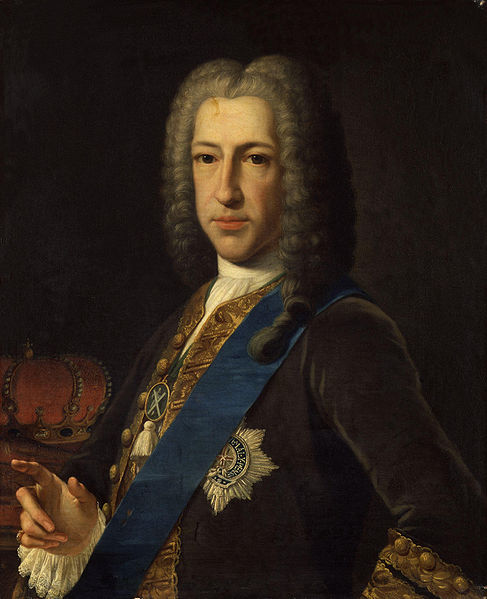
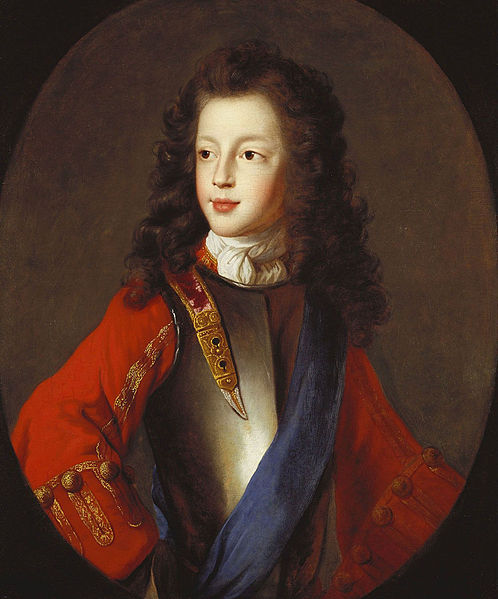
James Francis Edward, Prince of Wales (the Chevalier de St George or "The Old Pretender" or "The Old Chevalier"; 10 June 1688 - 1 January 1766) was the son of the deposed James II of England (James VII of Scotland). As such, he claimed the English, Scottish and Irish thrones (as James III of England and Ireland and James VIII of Scotland) from the death of his father in 1701, when he was recognized as king of England, Scotland and Ireland by his cousin Louis XIV of France. Following his death in 1766 he was succeeded by his son Charles Edward Stuart in the Jacobite Succession. Had his father not been deposed, there would have been only two monarchs during his lifetime; his father and himself. In reality there were six; the last three Stuarts and the first three Hanoverians. Although the ruling, Protestant, Stuarts died out with his half sister, Queen Anne, the very last remaining Stuarts were James and his sons, and their endeavors to regain their (putatively) rightful throne whilst remaining devoted to their Catholic faith is remembered in history as Jacobitism.
From the moment of his birth, on 10 June 1688, at St. James's Palace, the prince was the subject of controversy. He was born to the reigning king, James II of England (and VII of Scotland), and his Roman Catholic second wife, Mary of Modena, and as such was automatically Duke of Cornwall and Duke of Rothesay among other titles.
The Wars of Religion were fresh in the minds of the populace, and many British feared a revived Catholic dominance of the government. James II had two adult daughters from his first marriage, the future queens Princess Mary and Princess Anne, who had been raised as Protestants. As long as there was a possibility of one of them succeeding him, his opponents saw his rule as only a temporary aberration. When people began to fear that James's second wife, Mary, would produce a Catholic son and heir, a movement grew to replace him with his elder daughter Princess Mary and his son - in - law / nephew, William of Orange.
When the young prince was born, rumors immediately began to spread that he was an impostor baby, smuggled into the royal birth chamber in a warming pan. The true child of James and Mary was allegedly stillborn. On 10 December, within six months of his birth, Mary of Modena took baby James to France, worried about his safety, while his father continued to fight (unsuccessfully) to retain his crown. James and his sister Louisa Maria, were brought up in France. There, James was recognized by his cousin, King Louis XIV of France, as the rightful heir to the English and Scottish thrones and became the focus for the Jacobite movement.
On his father's death in 1701, James declared himself King, as King James III of England and VIII of Scotland and was recognized as such by France, Spain, the Papal States and Modena. These states refused to recognize William III, Mary II or Queen Anne as legitimate sovereigns. As a result of his claiming his father's lost thrones, James was attainted for treason in London on 2 March 1702, and his titles were forfeited under English law.
Having been delayed in France by an attack of measles, James attempted an invasion, trying to land at the Firth of Forth on 23 March 1708. His French ships were intercepted by the fleet of Admiral Sir George Byng. In spite of James' tearful pleas, the French admiral refused to let him go ashore, choosing to retreat rather than risk a naval battle.
Had he renounced his Roman Catholic faith, James might have strengthened the existing support of Tory, pro - Restoration, forces in England, but he refused to do so. As a result, in 1714, a German speaking Protestant became King of the recently created Kingdom of Great Britain — George I.
In 1713, the War of the Spanish Succession ended indecisively. Although the French forces and allies (of which Spain was one) were in complete control of Spain itself, they failed to retake the Spanish Crown's other European territories. Louis XIV of France accepted peace with Great Britain and her allies. He signed the Treaty of Utrecht, in 1713, that, among other conditions, required him to expel James from France.
In the following year, the Jacobites started "The 'Fifteen" Jacobite rising in Scotland, aimed at putting "James III and VIII" on the throne. In 1715, James finally set foot on Scottish soil, following the indecisive Battle of Sheriffmuir, but was disappointed by the strength of support he found. Timid and clearly uncomfortable with crowds, James failed to establish himself as a credible leader. He soon fell ill with fever, his illness made more severe by the icy Scottish winter. Instead of going through with plans for a coronation at Scone, he returned to France, sailing from Montrose. He was not welcomed back, because his patron, Louis XIV, was dead and the government found him a political embarrassment.
Pope Clement XI offered James the Palazzo Muti in Rome as his residence, and he accepted. Innocent XIII, like his predecessor, showed much support. Thanks to the mediation of a close friend of his, Cardinal Filippo Antonio Gualterio, James was granted a life annuity of eight thousand Roman scudi. Such help enabled him to organize a Roman Jacobite court, where he lived in splendor yet continued to suffer from fits of melancholy and depression. As the years passed, young "Roving Jamie" became known as "Old Mr. Misfortunate." He grew increasingly feeble and despondent, taking on the appearance and behavior of a much older man. The cruel and unflattering nickname reflected both his sad demeanor and the disappointment of his hopes. Nevertheless, he remained well treated in Rome until the end of his life. The Pope's cousin, Francesco Maria Conti of Siena, was the Gentiluomo di camera (Chamberlain).
Louise Adélaïde d'Orléans (Mademoiselle d'Orléans), daughter of Philippe II, Duke of Orléans, was at one time suggested as a wife for James Francis Edward Stuart, but nothing came of it.
On 3 September 1719, James Francis Edward Stuart married Maria Clementina Sobieska (1702 - 35), granddaughter of King John III Sobieski of Poland (and sister of Maria Karolina Sobieska). The wedding was held in the chapel of the Episcopal Palace in Montefiascone (near Viterbo).
They had two sons:
- Charles Edward Stuart (31 December 1720 - 31 January 1788), nicknamed "Bonnie Prince Charlie";
- Henry Benedict Stuart (11 March 1725 - 13 July 1807), Cardinal of the Roman Catholic Church.
Following James's failure, attention turned to his courageous and charismatic son Charles, "the Young Pretender", whose rebellion of 1745 came much closer to success than his father's. With the failure of this second rebellion, however, the Stuart hopes of regaining the British throne were effectively destroyed. James and Charles later clashed repeatedly, and relations between them broke down completely when James played a role in the election of his son Henry as a Cardinal (the celibacy required meaning that Henry would not have any children and could not carry on the line of succession) infuriating Charles who had not been consulted.
In 1759 the French government briefly considered a scheme to have James crowned King of Ireland, as part of their plans to Invade the British Isles but the offer was never formally made to James. Several separate plans also involved Charles being given control of a French backed independent Ireland.
James died in Rome on 1 January 1766, and was buried in the crypt of St. Peter's Basilica at the Vatican. His burial is marked by the Monument to the Royal Stuarts. Refusing to recognize James's eldest son Charles, from 14 January the Papacy instead accepted the Hanoverian dynasty as the legitimate rulers of Britain and Ireland. This led on to the slow reform of the anti - Catholic "Penal laws" in Britain and Ireland.
In 1792 the Papacy specifically referred to George III as the King of Great Britain and Ireland, leading to a Protest from James's second son, Henry, who was then the Jacobite claimant.
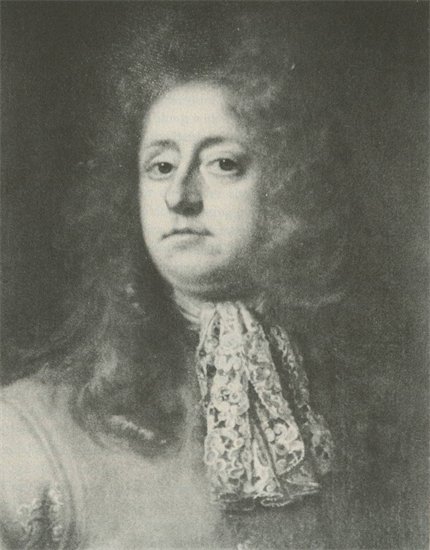
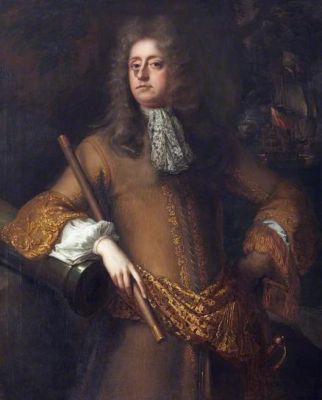
Arthur Herbert, 1st Earl of Torrington (c. 1648 - 13 April 1716) was a British admiral and politician of the late 17th and early 18th century. Cashiered as a rear - admiral by James II of England in 1688 for refusing to vote to repeal the Test Act, which prevented Catholics from holding offices, he brought the Invitation to William to The Hague, disguised as a simple sailor. As a reward he was made commander of William's invasion fleet during the Glorious Revolution.
Arthur was the son of the Attorney General and Lord Keeper of the Great Seal, Sir Edward Herbert of Aston, Montgomeryshire by his wife, Margaret, daughter of the Master of Requests, Thomas Smith of Abingdon, Berkshire (now Oxfordshire) & Parson's Green, Middlesex, and widow of Thomas Carey of Sunninghill Park, Berkshire. He was brother of Chief Justice Herbert, member for Dover, Master of the Robes, and rear - admiral of England. He was much loved by the sailors, and was reputed one of the best of the aristocratic class of naval officers. It had been generally supposed that he would readily comply with the royal wishes; for he was heedless of religion, he was fond of pleasure and expense, he had no private estates, his places (offices or employments) brought him in £4,000 a year, and he had long been reckoned among the most devoted personal adherents of James. When, however, the rear - admiral was closeted, and required to promise that he would vote for the repeal of the Test Act, his answer was, that his honor and conscience would not permit him to give any such pledge. "Nobody doubts your honour", said the King; "but a man who lives as you do ought not to talk about his conscience." To this reproach — a reproach which came from a bad grace from the lover of Catharine Sedley — Herbert manfully replied:- "I have my faults, sir; but I could name people who talk much more about conscience than I am in the habit of doing, and yet lead lives as loose as mine." He was dismissed from all his places.
During the reign of William and Mary, he served as Lord High Admiral (1689) and then First Lord of the Admiralty (1689 - 1690). Torrington played an important role in the War of the Grand Alliance, commanding the English and Dutch fleets at the Battle of Beachy Head (30 June 1690 O.S), a serious defeat for the allied fleet. He was imprisoned in the Tower of London and court - martialed for failing to support the Dutch van squadron against the French, but was acquitted. Nevertheless he lost his position as First Lord of the Admiralty. The stories that Torrington was not a popular commander, because of his reputation of being a drunk and his habit of taking several prostitutes with him to sea, are in fact untrue.
In connection with his 1690 operations against the French, the Earl is credited with being the first to use the expression, 'fleet in being'. Torrington proposed avoiding a set battle, except under very favorable conditions, until the arrival of reinforcements. By maintaining his fleet in being, he would force the French to remain in the area and prevent them from undertaking other operations.